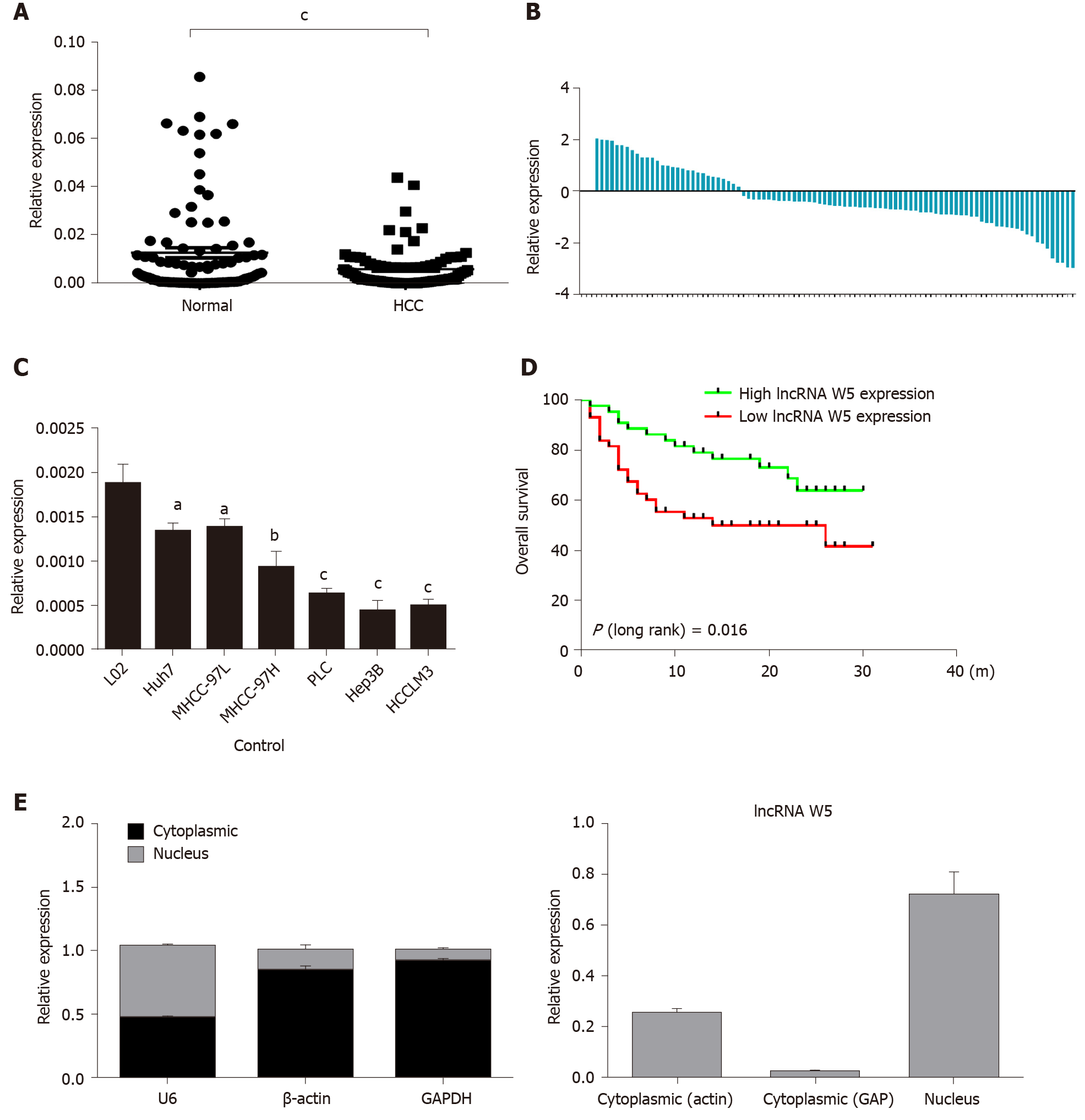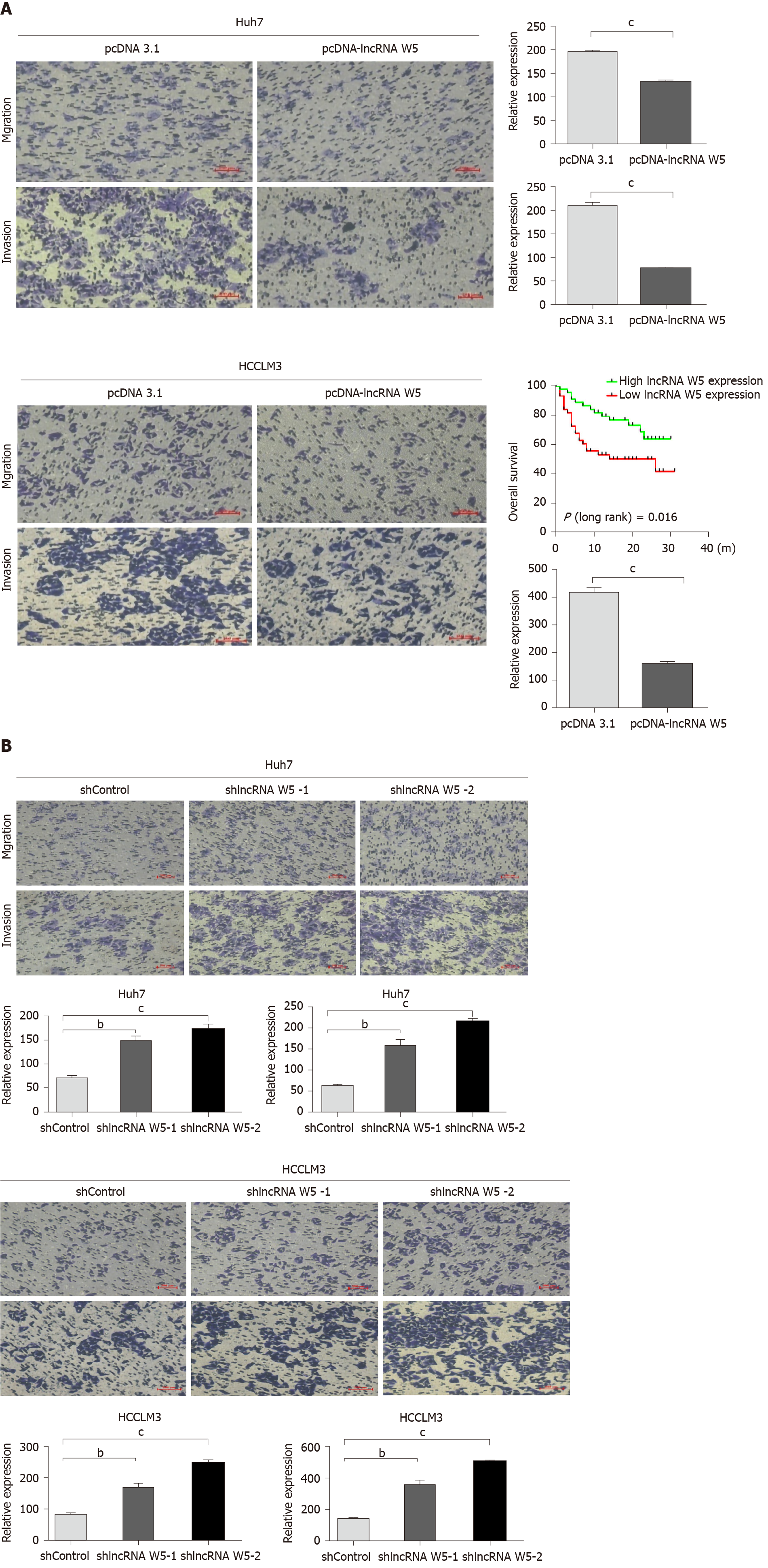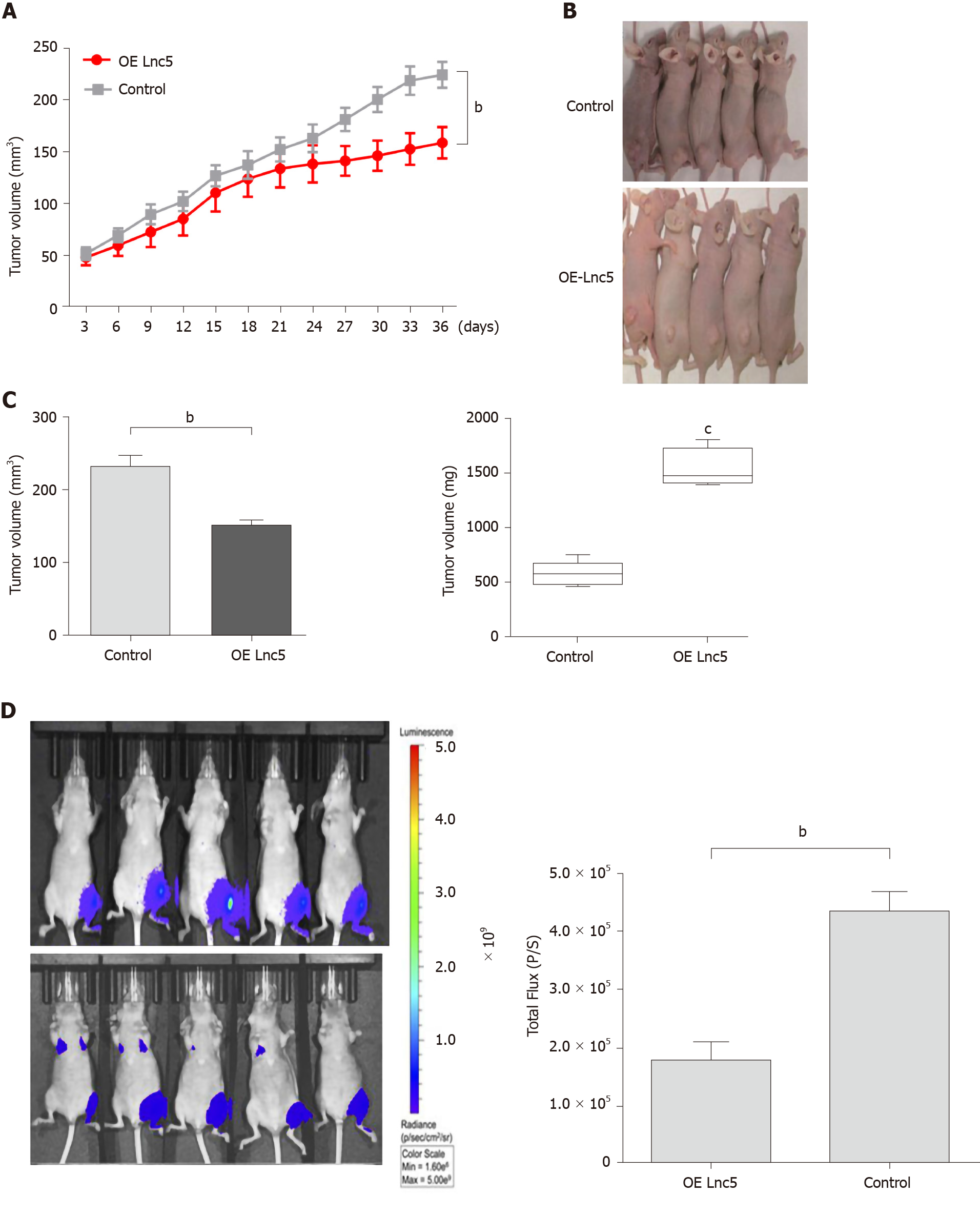Copyright
©The Author(s) 2021.
World J Gastroenterol. Jan 7, 2021; 27(1): 55-68
Published online Jan 7, 2021. doi: 10.3748/wjg.v27.i1.55
Published online Jan 7, 2021. doi: 10.3748/wjg.v27.i1.55
Figure 1 Expression of long non-coding ribonucleic acid W5 is downregulated in hepatocellular carcinoma tissues and cells.
A: The expression of long non-coding ribonucleic acid (lncRNA) W5 was detected by reverse transcription-polymerase chain reaction (qRT-PCR) in tumor tissues and non-adjacent normal tissues of hepatocellular carcinoma (HCC) patients (n = 86). LncRNA W5 expression was normalized to GAPDH expression; B: The expression of lncRNA W5 was detected by qRT-PCR in tumor tissues and non-adjacent normal tissues of 86 HCC patients; C: The expression levels of lncRNA W5 in a series of HCC cell lines were reduced compared to that in LO2 cells; D: Analysis of overall survival based on lncRNA W5 expression levels is shown in 86 HCC patients; and E: Subcellular localization of lncRNA W5 in Huh7 cells was examined by qRT-PCR. GAPDH, β-actin and U1 were considered as the control markers, respectively. aP < 0.05; bP < 0.01; cP < 0.001. HCC: Hepatocellular carcinoma; lncRNA: Long non-coding ribonucleic acid; qRT-PCR: Reverse transcription-polymerase chain reaction.
Figure 2 In vitro suppression of long non-coding ribonucleic acid W5 in hepatocellular carcinoma proliferation.
A: Increased long non-coding ribonucleic acid (lncRNA) W5 expression in Huh7 and LM3 cells was confirmed after over-expressed lncRNA W5 transfection by reverse transcription-polymerase chain reaction. LncRNA W5 expression was normalized to GAPDH. cP < 0.001; B: Cell viability of pCDNA-3.1 LncRNAW5-transfected Huh7 and LM3 cells were detected by CCK-8 assays. Cell number was determined every 24 h up to 96 h. The results are shown as the mean ± SE from three independent experiments. aP < 0.05; bP < 0.01. cP < 0.001, compared with the control by two-sided t-test; C: Colony-forming assay was used to determine the effect of lncRNA W5 on the proliferation in Huh7 and LM3 cells; D: Decreased lncRNA W5 expression in Huh7 and LM3 cells was confirmed after sh-1 or sh-2 LncRNAW5 transfection by reverse transcription-polymerase chain reaction. LncRNA W5 expression was normalized to GAPDH. aP < 0.05; bP < 0.01. cP < 0.001; E: Cell viability of sh-1 or sh-2 LncRNAW5-transfected Huh7 and LM3 cells were detected by CCK-8 assays. Cell number was determined every 24 h up to 96 h. The results are shown as the mean ± SE from at least three independent experiments. aP < 0.05; bP < 0.01. cP < 0.001, compared with the control by two-sided t-test; and F: Colony-forming assay was used to determine the effect of sh-1 or sh-2 LncRNA W5 on the proliferation of Huh7 and LM3 cells.
Figure 3 Effects of long non-coding ribonucleic acid W5 on hepatocellular carcinoma migration and invasion.
A: Cell migration and invasion abilities were determined after transfection with pcDNA-3.1 and pcDNA-3.1 long non-coding ribonucleic acid W5 in Huh7 and LM3 cell lines, respectively; B: Cell migration and invasion abilities were determined after transfection with sh-1 or sh-2 LncRNA W5 in Huh7 and LM3 cell lines, respectively. All experiments were performed in triplicate. aP < 0.05; bP < 0.01; cP < 0.001.
Figure 4 Long non-coding ribonucleic acid W5 inhibits tumor growth in vivo.
A: Huh7 cells (5 × 106) stably expressed with long non-coding ribonucleic acid W5 (lncRNA W5) were subcutaneously injected into the left flank of nude mice, and the effect of lncRNA W5 on hepatocellular carcinoma tumor growth was examined every 3 d during the course of the experiment (n = 5); B: A representative image of the xenograft-bearing mice; C: Tumors were isolated from the nude mice after sacrifice. The effects of lncRNA W5 on hepatocellular carcinoma growth were determined by tumor volume and tumor weight; D: LncRNA W5-overexpressing Huh7 cells which stably expressed luciferase were injected into nude mice (n = 5). The bioluminescence photographs of tumor were recorded with the in vivo 200 Imaging System. A representative luciferase signal was recorded from each group at 6 wk after injection. bP < 0.01.
- Citation: Lei GL, Fan HX, Wang C, Niu Y, Li TL, Yu LX, Hong ZX, Yan J, Wang XL, Zhang SG, Ren MJ, Yang PH. Long non-coding ribonucleic acid W5 inhibits progression and predicts favorable prognosis in hepatocellular carcinoma. World J Gastroenterol 2021; 27(1): 55-68
- URL: https://www.wjgnet.com/1007-9327/full/v27/i1/55.htm
- DOI: https://dx.doi.org/10.3748/wjg.v27.i1.55












